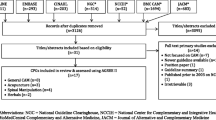Abstract
An evidence-based practice method according to literature retrieval through PICO (Patients, Intervention, Comparison, Outcome) questions and complementary and alternative medicine (CAM) topics, which can obtain helpful evidence for guiding clinical practice, was introduced with a practical example in this paper. The knowledge of diseases and Western medicine treatment can be acquired by literature retrieval through PICO question, while searching by CAM topics may provide evidence for Chinese medicine (CM). Thus the author held that literature retrieval through both PICO question and CAM topics was an ideal evidence-based practice method for integrative Chinese and Western medicine (ICWM). However, since the standard in CM evidence hierarchy is still under study, the value of the CAM thematic retrieval method remains very limited. In the future, studies on the definition and hierarchy of CM evidences and the herb-drug interaction between Western and Chinese medicine during a combination therapy should be strengthened to improve the status of ICWM evidence-based practice.
Similar content being viewed by others
References
Wang JL. Evidence based medicine. 1st ed. Beijing: People’s Medical Publishing House; 2001:5–6,9–11.
Xu H, Chen KJ. Integrative medicine: the experience from China. J Altern Complem Med 2008;14(1):3–7.
Xu H, Chen KJ. Herb-drug interaction: an emerging issue of integrative medicine. Chin J Integr Med 2010;16(6):195–196.
Sachett DL, Straus SE, Richardson WS. How to practice and teach EBM. 2nd ed. Translated by Zhan SiYan. Beijing: Peking University Medical Press; 2006:3.
Schardt C, Adams MB, Owens T, Keitz S, Fontelo P. Utilization of the PICO framework to improve searching PubMed for clinical questions. BMC Medical Informatics and Decision Making 2007, 7:16 (http://www.biomedcentral.com/1472-6947/7/16).
Sackett DL, Straus SE, Richardson WS, Rosenberg W, Haynes RB. Evidence-based medicine: how to practice and teach EBM. 2nd ed. Edinburgh: Churchill Levingstone; 2000:173–177.
http://img.medscape.com/fullsize/migrated/514/327/ajt514327.tab1.gif.
Dennett L, Chatterley T. Health technology assessment on the net: a guide to internet sources of information. 10th ed. Albert Canada: Institute of Health Economics Report; June 2008.
ACC/AHA/ESC 2006 Guidelines for the Management of Patients with Atrial Fibrillation. A Report of the American College of Cardiology/American Heart Association Task Force on Practice Guidelines and the European Society of Cardiology Committee for Practice Guidelines. http://www.acc.org/qualityandscience/clinical/guidelines/atria_fib/pdfs/af_full_test.pdf.
Opolski G, Torbicki A, Kosior D, Szulc M, Zawadzka M, Pierścińska M, et al. Rhythm control versus rate control in patients with persistent atrial fibrillation. Results of the HOT CAFE Polish Study. Kardiol Pol 2003;59:1–16.
Saxonhouse SJ, Curtis AB. Risks and benefits of rate control versus maintenance of sinus rhythm. Am J Cardiol 2003;91:27D–32D.
de Denus S, Sanoski CA, Carlsson J, Opolski G, Opolski G, Spinler SA. Rate vs. rhythm control in patients with atrial fibrillation: a meta-analysis. Arch Intern Med 2005;165:258–262.
Testa L, Biondi-Zoccai GG, Dello Russo A, Bellocci F, Andreotti F, Crea F. Rate-control vs. rhythm-control in patients with atrial fibrillation: a meta-analysis. Eur Heart J 2005;26:2000–2006.
Rienstra M, Van Veldhuisen DJ, Crijns HJ, Van Gelder IC. Enhanced cardiovascular morbidity and mortality during rhythm control treatment in persistent atrial fibrillation in hypertensives: data of the RACE study. Eur Heart J 2007;28:741–751.
Groenveld HF, Crijns HJ, Rienstra M, Van den Berg MP, Van Veldhuisen DJ, Van Gelder IC. Does intensity of rate control influence outcome in persistent atrial fibrillation? Data of the RACE study. Am Heart J 2009;158:785–791.
Nikolaidou T, Channer KS. Chronic atrial fibrillation: a systematic review of medical heart rate control management. Postgrad Med J 2009;85:303–312.
Veloso HH, de Paola AA. Beta-blockers versus digoxin to control ventricular rate during atrial fibrillation. J Am Coll Cardiol 2005;45:1905–1906.
Aronow WS. Management of atrial fibrillation in the elderly. Minerva Med 2009;100:3–24.
Engelsen J, Nielsen JD, Hansen KF. Effect of Coenzyme Q10 and Ginkgo biloba on warfarin dosage in patients on long-term warfarin treatment. A randomized, double-blind, placebo-controlled cross-over trial. Ugeskr Laeger 2003;165:1868–1871.
Savović J, Wider B, Ernst E. Effects of Ginkgo biloba on blood coagulation parameters: a systematic review of randomised clinical trials. Evidence-Based Integr Med 2005;2:167–176.
Tachjian A, Maria V, Jahangir A. Use of herbal products and potential interactions in patients with cardiovascular diseases. J Am Coll Cardiol 2010;55:515–525
Shekelle PG, Morton SC, Suttorp MJ, Buscemi N, Friesen C. Challenges in systematic reviews of complementary and alternative medicine topics. Ann Intern Med 2005;142:1042–1047.
Author information
Authors and Affiliations
Corresponding author
Additional information
Supported by National Nature Science Foundation of China (No. 30973702); Beijing Project of Science and Technology Plan (No. D0805703020801); Major Discipline Project of China-Japan Friendship Hospital
Rights and permissions
About this article
Cite this article
Yan, Xf., Ni, Q., Wei, Jp. et al. Evidence-based practice method of integrative Chinese and Western medicine based on literature retrieval through PICO question and complementary and alternative medicine topics. Chin. J. Integr. Med. 16, 542–548 (2010). https://doi.org/10.1007/s11655-010-0570-5
Received:
Published:
Issue Date:
DOI: https://doi.org/10.1007/s11655-010-0570-5



